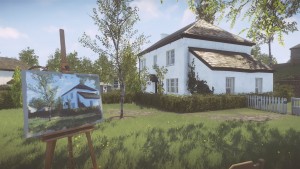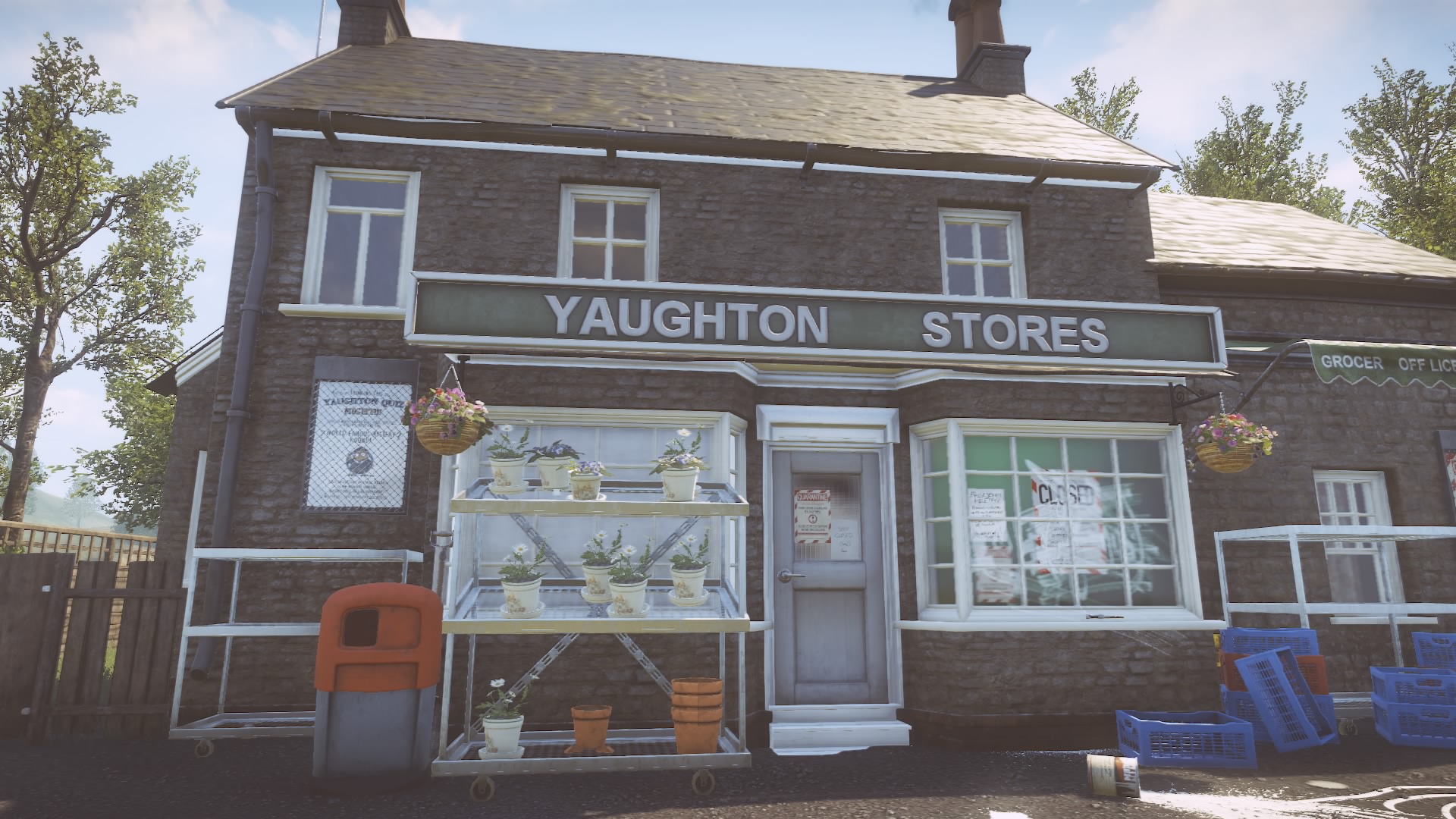 I find the term “walking around simulator”, which games like this have often been categorised as, somewhat derogatory. It’s as if there’s nothing to the game at all, bar walking around, and it should be derided because of this. Which is missing the point. The aim of these games is not to “win”, not to solve puzzles and leap gaps and shoot Nazis, but to discover the story. Yes, you do this by walking around, but there’s more to it than that.
I find the term “walking around simulator”, which games like this have often been categorised as, somewhat derogatory. It’s as if there’s nothing to the game at all, bar walking around, and it should be derided because of this. Which is missing the point. The aim of these games is not to “win”, not to solve puzzles and leap gaps and shoot Nazis, but to discover the story. Yes, you do this by walking around, but there’s more to it than that.
 In Everybody’s Gone to the Rapture, erm, everybody’s gone to the rapture. You start off as an unknown person on the outskirts of a Shropshire village in 1984, near an observatory. You can’t enter the observatory as the gates are locked, so you need to travel a massive loop of the village to try and get in the back way. As soon as you set off you hear a radio message which alerts you to “an event”, and as you explore the village radios and telephones start to fill in some of the story behind what happened.
In Everybody’s Gone to the Rapture, erm, everybody’s gone to the rapture. You start off as an unknown person on the outskirts of a Shropshire village in 1984, near an observatory. You can’t enter the observatory as the gates are locked, so you need to travel a massive loop of the village to try and get in the back way. As soon as you set off you hear a radio message which alerts you to “an event”, and as you explore the village radios and telephones start to fill in some of the story behind what happened.
Along the way, orbs of light direct you to places of interest, where you see some conversations and actions leading up to The Event played out. Technically, you can just walk past everything and head for the end of the game, but then you really do have just a walking around simulator on your hands, and you’re missing both the point and the game.
When you reach the end, there’s no decisive conclusion and no full exposition of exactly what happened. It’s up to you to formulate in your head what you think occurred based on what you’ve seen and heard, and how you interpret what the “glowing light” actually is.
Almost as much fun as putting this together yourself, is reading what other people thought and how their theories compare to your own. With that in mind, here’s a big spoiler:
[spoiler]
I think it’s quite clear the light is some sort of alien intelligence. Kate and Stephen somehow managed to coax it over to Earth either purposefully or by accident.
It then attempted to communicate with us on Earth, mistakenly trying to talk to the birds first (killing them, which is why they’re all dead everywhere), then other animals (including the cows – they’re all dead too), before being more successful with humans.
In the end, I guessed the character you’re walking round as is actually Kate, and the light “thing” is Kate’s partner. Everyone else got to be with their partner once “raptured”, Kate became one with it and then revisited all the rapturings (i.e. you playing the game) – that’s why the light is guiding her to the end. She says she was able to hold time still and see how everyone left and where they went.
[/spoiler]
Obviously, there’s more to it than all this, but I’m not intending to write a dissertation! There are a lot of side stories as well, like the love triangle between Stephen, Lizzie and Kate, or Frank’s difficult relationship with his sister, all of which are explored literally by exploring. It’s intriguing and compelling finding out everything you can from the clues left behind, and the English village setting is beautiful to wander round.
 The only minor negatives I have are that sometimes the walking pace, even with the “jog” button, is much too slow (especially when you realise you’ve missed something and have to backtrack for miles), and that there is a huge amount of asset reuse. The same shed, greenhouse, plastic garden table, white sheets on the washing line, Raleigh Burner-alike BMX bike and books are everywhere, repeated over and over again. Houses all have the same kitchen. Even the two pubs in the village have exactly the same “special offers board” and virtually the same layout inside. The worst copy and paste job is the large number of cars that are around the village – of which there are only about 5 or 6 types. This wouldn’t be a problem but they’re not just the same type of car, they’re exactly the same car with the same colour and same number plate.
The only minor negatives I have are that sometimes the walking pace, even with the “jog” button, is much too slow (especially when you realise you’ve missed something and have to backtrack for miles), and that there is a huge amount of asset reuse. The same shed, greenhouse, plastic garden table, white sheets on the washing line, Raleigh Burner-alike BMX bike and books are everywhere, repeated over and over again. Houses all have the same kitchen. Even the two pubs in the village have exactly the same “special offers board” and virtually the same layout inside. The worst copy and paste job is the large number of cars that are around the village – of which there are only about 5 or 6 types. This wouldn’t be a problem but they’re not just the same type of car, they’re exactly the same car with the same colour and same number plate.
 Sometimes you can see that it’s intentional, with, for example, a car appearing in one location with a Peter Pan hat and swords inside, then appearing later at the holiday camp where the kids were performing Peter Pan, but most of the time it’s just jarring. In one case there’s a carpark with two instances of the exact same van in it! There’s no reason why they couldn’t have replaced the number plates and colour-swapped the cars to mix it up a bit, surely? Or had a red-and-yellow Burner instead of a blue-and-yellow one occasionally? I realise it was a small team making the game, but this would surely have been a tiny job compared to the rest?
Sometimes you can see that it’s intentional, with, for example, a car appearing in one location with a Peter Pan hat and swords inside, then appearing later at the holiday camp where the kids were performing Peter Pan, but most of the time it’s just jarring. In one case there’s a carpark with two instances of the exact same van in it! There’s no reason why they couldn’t have replaced the number plates and colour-swapped the cars to mix it up a bit, surely? Or had a red-and-yellow Burner instead of a blue-and-yellow one occasionally? I realise it was a small team making the game, but this would surely have been a tiny job compared to the rest?
 Another thing which was unimportant in the end but seemed necessary to record along the way was all the numbers broadcast on the radios (identical radios…). I started to get a little paranoid that I might miss one. Then I wondered if the names of the books were important. Or the times on the clocks (which were all stopped at the same time, as it turned out). Or the car number plates. I ended up documenting everything and – of course – none of it was needed. In fact, there was nothing you could even do with this information anyway. This wasn’t the game’s fault of course, more mine for not having any idea what to expect and not wanting to miss anything that may be required later on. For new players: read and listen, but don’t bother making notes.
Another thing which was unimportant in the end but seemed necessary to record along the way was all the numbers broadcast on the radios (identical radios…). I started to get a little paranoid that I might miss one. Then I wondered if the names of the books were important. Or the times on the clocks (which were all stopped at the same time, as it turned out). Or the car number plates. I ended up documenting everything and – of course – none of it was needed. In fact, there was nothing you could even do with this information anyway. This wasn’t the game’s fault of course, more mine for not having any idea what to expect and not wanting to miss anything that may be required later on. For new players: read and listen, but don’t bother making notes.
Should you play Everybody’s Gone to the Rapture? Absolutely. Will you understand what you’ve just played when you come to the end? Possibly. Will it matter if you don’t? No, I don’t think so.



